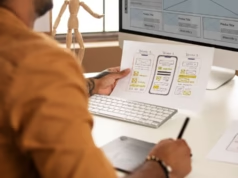What Is AI Food Photography?
Food photography has always been about making dishes look mouthwatering. But here’s the catch—traditional food photography often required expensive equipment, stylists, and hours of manual editing.
Now, enter AI food photography. It’s a blend of creative artistry and advanced technology. Using AI-driven tools, photographers and marketers can enhance food images automatically—adjusting lighting, removing imperfections, sharpening details, and even generating realistic textures.
It’s no longer just about taking photos. It’s about creating a digital experience where food looks tastier, fresher, and more appealing than reality.
Why Food Photography Matters in Marketing
A single food photo can make or break a restaurant’s reputation. Think about it—when you scroll through delivery apps, what grabs your attention? The photo. Not the name of the dish. Not even the description.
Studies show that people are 60% more likely to order food if they see an appetizing picture. That’s why businesses invest in visuals. A burger shot with perfect lighting sells better than one taken under dull fluorescent lamps.
But traditional setups are expensive. That’s why ai food photography has become a game-changer—it lowers cost while increasing quality.
How AI Is Changing Food Photography
AI doesn’t just retouch photos. It redefines them. Let’s break down how.
- Automatic Lighting Adjustments
AI corrects shadows, highlights, and uneven tones. Food appears fresh, colorful, and appetizing instantly. - Smart Background Removal
No need for long manual edits. AI cuts out messy backgrounds and replaces them with clean, branded visuals. - Texture Enhancement
Ever seen cheese on pizza look perfectly melted in ads? That’s often AI sharpening textures, making them irresistible. - Batch Editing
Restaurants and delivery apps handle hundreds of photos. Image editing with AI processes them in bulk, saving time. - Creative Variations
AI can test different styles—warm tones for comfort food, cool tones for fine dining, vibrant colors for desserts.
Storytelling in AI Food Photography
Food is emotional. It connects to culture, memories, and comfort. A great photo doesn’t just show what a dish looks like. It tells a story.
Imagine two images of soup. One is a plain bowl shot from above. The other shows steam rising, with bread on the side, warm light pouring in. Which one makes you want to taste it?
That’s where ai food photography shines. It adds depth and atmosphere. AI tools can simulate steam, enhance gloss, or brighten natural colors, turning a simple photo into an emotional experience.
Who Uses AI Food Photography?
It’s not just big brands. Different industries rely on it today.
- Restaurants – To promote menus online and on delivery platforms.
- Food Bloggers – To make recipes more engaging.
- E-commerce Stores – Selling packaged foods requires polished product images.
- Marketing Agencies – For client campaigns that need speed and high-quality output.
- Food Apps – Uber Eats, DoorDash, and similar platforms benefit from consistent photo quality.
Even small cafes are adopting image editing with AI to compete with larger chains.
Benefits of AI Food Photography
Why is everyone talking about it? Because it delivers results.
- Faster turnaround – Hours of editing reduced to minutes.
- Lower cost – No need for expensive studios.
- Consistency – Every dish looks equally professional.
- Better engagement – Higher clicks and conversions on ads.
- Scalability – Works for 10 images or 10,000.
In short, it democratizes professional food visuals.
Challenges in Traditional Food Photography
Before AI, food photography was tough. Here’s why.
- Food melts, fades, or dries quickly during shoots.
- Lighting setups required big budgets.
- Post-processing consumed hours.
- Results often depended too much on photographer skill.
Now, with ai food photography, many of these issues vanish. AI tools stabilize colors, preserve freshness, and enhance shots even if conditions weren’t perfect.
How Image Editing With AI Complements Food Photography
The two go hand in hand. Capturing a great photo is step one. Refining it is step two.
Image editing with AI makes refinement effortless. For example:
- Cropping and framing automatically.
- Enhancing sharpness without losing natural appeal.
- Fixing blemishes like smudges on plates.
- Adjusting colors to match brand identity.
Think of AI editing as the finishing touch that makes food photography shine.
Real-World Example
A bakery launches new cupcakes. Traditionally, they’d hire a photographer, rent lights, and spend hours editing. With ai food photography, they take simple shots with a smartphone. AI adjusts lighting, removes table clutter, and enhances frosting colors.
Then, image editing with AI ensures every cupcake looks identical in branding style. Within a week, the bakery’s online orders double.
That’s real impact.
Types of AI Tools Used in Food Photography
Not all AI tools are equal. Some specialize in retouching, others in styling.
- Background Removal AI – Perfect for menu photos.
- Color Enhancement AI – Adjusts saturation for appetizing tones.
- Lighting AI – Simulates natural daylight even indoors.
- Texture AI – Adds crispness to toppings, sauces, and layers.
- Generative AI – Creates styled backgrounds without a physical set.
These tools turn simple images into professional ads.
How to Start With AI Food Photography
Getting started is easier than people think.
- Shoot Simple Photos – A smartphone works fine.
- Upload to AI Tools – Platforms process images instantly.
- Apply Style Templates – Choose warm, modern, or vibrant tones.
- Batch Edit – Edit multiple dishes at once.
- Test Performance – Use A/B testing on menus and ads.
Restaurants often see immediate boosts in clicks after upgrading visuals.
What Makes AI Food Photography Different From Regular Editing?
The difference is speed and intelligence. Traditional editing relies on human precision. AI editing learns patterns and improves automatically.
For example, if AI sees 500 pasta photos, it understands what “good pasta” looks like. It then applies the same style to future shots, creating consistency across campaigns.
That’s what makes image editing with AI superior for scaling businesses.
Common Mistakes to Avoid
AI isn’t perfect. Misuse can harm results.
- Over-saturation – Makes food look fake.
- Unrealistic Shadows – Can ruin natural appeal.
- Ignoring Brand Identity – Not every dish needs the same tone.
- Excessive Filters – Over-editing disconnects customers.
Balance is key. Subtle edits keep food believable.
Best Practices for Using AI in Food Photography
- Keep colors natural, not artificial.
- Highlight textures—crispy edges, creamy sauces, fresh toppings.
- Use consistent lighting styles across all photos.
- Test photos on real audiences before campaigns.
- Combine AI with human creativity for best results.
These practices ensure photos look authentic while still benefiting from technology.
Future of AI Food Photography
The future looks exciting. AI will not just edit photos. It may generate entire food campaigns—styled backgrounds, realistic steam, and even animated dishes for ads.
Image editing with AI will integrate deeper into marketing platforms. Imagine uploading a menu and instantly getting ad-ready visuals across Instagram, websites, and delivery apps.
Some experts even predict AI-generated food that doesn’t exist yet, created purely for visual campaigns.
Why This Matters for Businesses
Consumers buy with their eyes. That’s why restaurants, brands, and food creators can’t ignore ai food photography. It offers professional-quality visuals without massive budgets.
Small businesses now compete visually with large corporations. That levels the playing field.
And since marketing is heavily image-driven, those who adapt to AI editing early will stay ahead.
Conclusion
Food photography has always been a powerful marketing tool. But now, with the rise of ai food photography, businesses can create stunning visuals quickly, cheaply, and consistently.
When paired with image editing with AI, the results are even more striking. From texture enhancement to background clean-up, AI tools transform everyday food shots into campaign-ready masterpieces.
The future of food marketing is clear—authentic visuals powered by AI. Brands that embrace this technology will connect better with audiences, drive higher engagement, and ultimately sell more.
Because in the end, people don’t just eat food. They eat with their eyes first.







